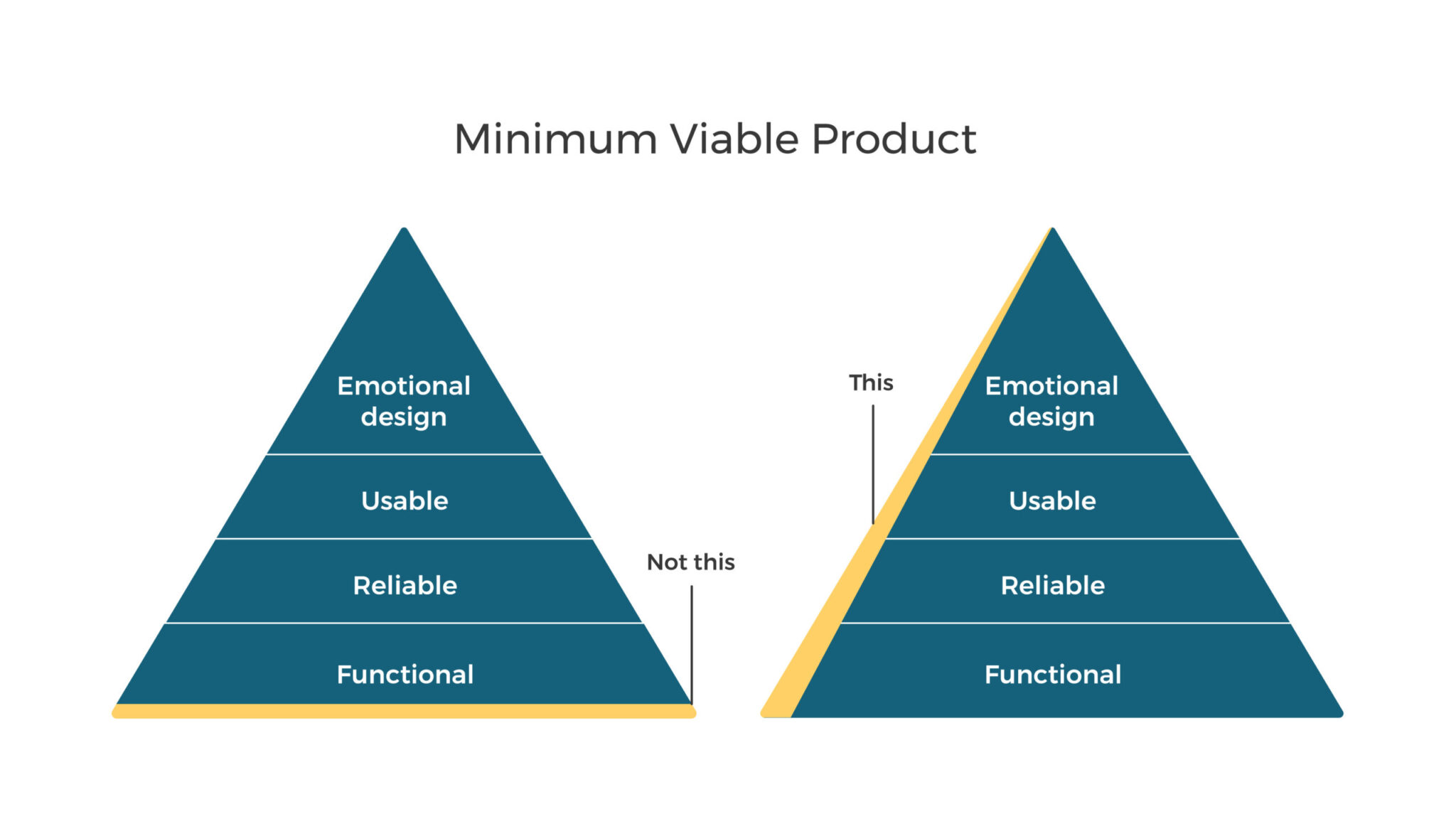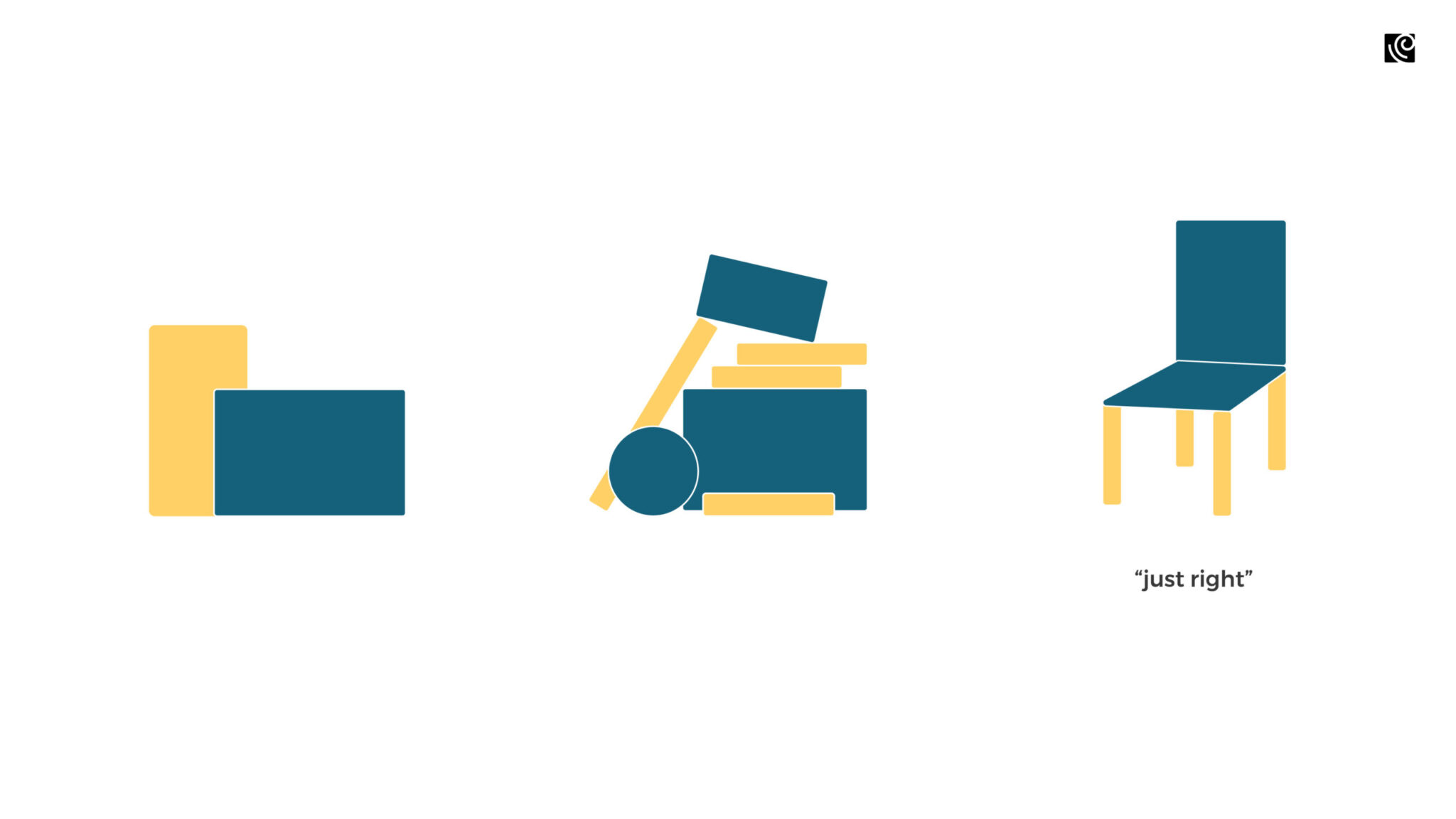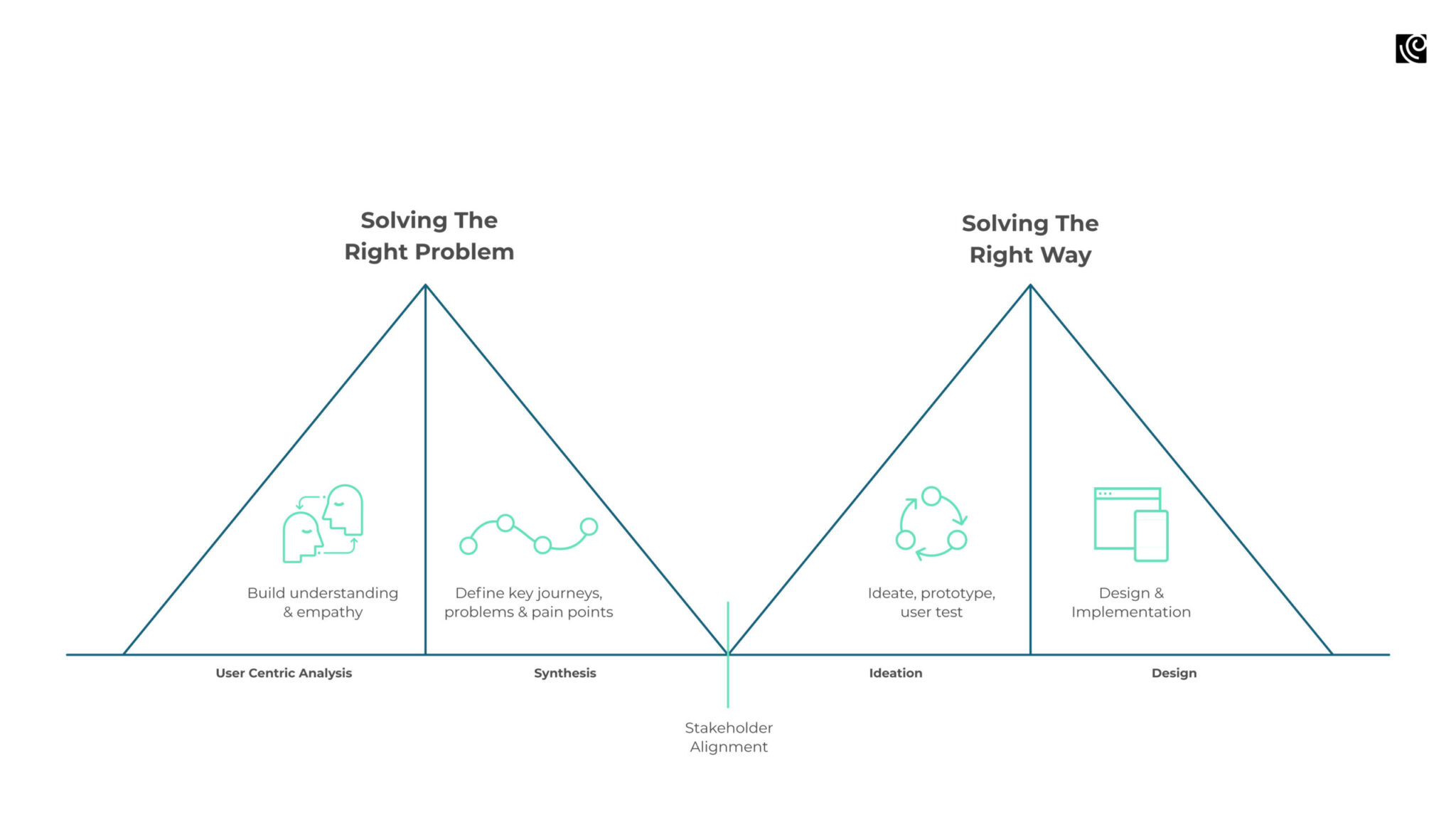The term ‘Minimum Viable Product’, or MVP was first coined by product development expert, Frank Robinson, who defined it to be a product with a set of core features that allows it to be used in a way it’s meant to be, and nothing more. In other words, an MVP is “The smallest thing that you can build that delivers customer value (and as a bonus captures some of the value back).”
The concept of MVP was proliferated by Steve Blank, a leading voice in Product Design, and Eric Ries, the pioneer of the Lean Design Startup movement. From the perspective of a startup, it is immensely crucial that the basic viability of the business model needs to be rock solid. This way, the progress curve for new ventures begins with learning and proving viability, and then moving on to revenue and profits in the longer term.
MVP is a Process, Not a Product
Now, the definition of an MVP tells us that it needs to possess the bare minimum features at its core and nothing more. However, what is more important is that the MVP be treated as a process and not as an end result. The MVP process can be applied to creating a range of products and business models.
In the words of Eric Ries, “As you consider building your own minimum viable product, let this simple rule suffice: remove any feature, process, or effort that does not contribute directly to the learning you seek.”

Let’s get to know an MVP from a product perspective. The goal to have while building an MVP is to create a product that you can test to gauge if people actually use or pay for. The aim is to test this product on some users and then collate maximum information on its functionality/viability with minimal effort.
Quite a few memorable success stories can trace their beginnings in the MVP process. Uber comes to mind almost instantly, with founder Garrett Camp looking to find a way to reduce the cost of traveling within the city. The answer was simple – to distribute costs by sharing rides with other passengers. The founders started off with creating an app that allowed users to hail a black luxury car with rides priced 1.5 times that of a regular taxi. This was followed by including non-luxury vehicles in their fleet, which received a fabulous response. The company has gone on to include carpooling, peer-to-peer car sharing, renting vehicles, to even food delivery by 2019.
Airbnb began on similar lines when the founders, roommates Brian Chesky and Joe Gebbia decided to offer the spare space in their apartment to renters who found San Francisco’s rental prices too high. Shortly after moving to San Francisco in October 2007, they came up with the idea of putting an air mattress in their living room and turning it into a bed and breakfast. Soon, a website was up and running, offering short-term housing, breakfast, and a business networking opportunity for those who were unable to book a hotel in the saturated market, naming it Air Bed & Breakfast.
By 2009, the name of the company was shortened to Airbnb.com, and the site’s content had expanded from air beds and shared spaces to a variety of properties including entire homes and apartments, private rooms, and other properties. About a decade later in 2018, the company announced Airbnb Plus, a collection of homes carefully selected for quality of services, comfort, and design, as well as Beyond by Airbnb, offering luxury vacation rentals.
It just goes to reiterate that an MVP is one that is built to serve a core solution to an existing problem faced by users. It can only be developed with a razor-sharp focus only and only on solving a problem or serving an existing need, sans the bells and whistles. The secret of the success enjoyed by Uber and Airbnb can be attributed to their implementation using the MVP process. These are perfect examples of MVPs – simple in their execution and solving a pressing need of users. What’s more, these products right from their inception stage helped in collating a lot of important user data to refine and improve their functionality.
This is a key benefit of an MVP – allowing the product team to gather ample amounts of user data, which is put to use in bettering the product with time.
A point of caution!
A lot of the apprehension that stakeholders harbor regarding an MVP is that it’s an incomplete product that’s released out to users, and therefore, is bound to fail. This couldn’t be any farther from the truth. An MVP is a complete product created to serve a well-defined user need. It is not a half-baked product released to gather user feedback.

An MVP is also at times misunderstood to be a prototype or proof of concept. It’s not! MVPs are fully functional products that are ready for usage.
The Role of UX in Developing an MVP
Now, the concept of MVP mandates that it has to provide basic operational features and functionality. Based on the user feedback received on this, the product team continues to add refinements to better the user experience. The key here, notably, is to find the right set of features that can be defined as ‘basic’. It isn’t too different from the Goldilocks dilemma – it shouldn’t be so basic that it’s deemed useless; it can’t be so complicated that it puts off users; it needs to be just right.

The ‘V’ in MVP stands for ‘Viability’ which is its primary attribute. As minimalistic as it may be, an MVP has to work in a glitch-free manner. It needs to be useful, seamless, and hopefully, bring delight to its users as well. Sound familiar? Yes, the User Experience design process is integral to creating an MVP.
An MVP is essentially a condensed version of a product that addresses a specific subset of user needs within the context of a broader business strategy. That’s why its functionality can be based only on a solid UX strategy.
UX design employs empathy and intuition to create a human-centric approach that manages a human’s interaction with technology. The examples of Airbnb and Uber come to mind in this context, where the founders chose to solve their own user needs. Needs that were indeed common across the population. By putting themselves in the shoes of hundreds of other users, they were able to devise solutions that resonated and welcomed. Thus, UX takes into consideration all the aspects affecting a user’s perceptions and emotions before, during, and after their interaction with a digital product or service.
UX Design, Development, and the MVP Process
The UX design process begins with in-depth research into user behavior and psychology – the way they think, their preferences and dislikes, what they value, and above all – why they feel the way they do. The UX research process helps the business to effectively gain insights about their users. This helps in realigning complex business problems from the users’ perspective, identifying what’s most important to them. This way, the UX design process helps a business build a user experience that consistently generates value.
It does seem inconceivable at first, doesn’t it? Conducting a UX research study, then synthesizing those findings, ideate on the basis of those findings, iteratively test solutions and then finally move into design – this is what the design process entails. It takes months to complete, which is why the MVP mindset seems a bit out of place.
However, the two aren’t so different from each other after all. Implementing the UX design process with an MVP mindset is possible owing to the common ground of incremental changes and iterative development.

UX Process – Research → Synthesis → Ideation → Design

MVP Process – Build → Measure → Learn → Repeat
Building an MVP is all about creating a product in the shortest time possible, offering the absolute minimum set of features deemed acceptable by users. Therefore, to embed this into the UX process requires a highly collaborative approach to project execution, with the participation of team members who enjoy offering up their specialized insights. Cross-functional teams that bring their multidisciplinary perspectives lead to better design solutions.
Design is an iterative medium that pushes businesses to think critically and solve problems in a human-centric manner. It also follows the maxim of test early and fail fast – this way, a multitude of solutions are tested before landing upon the right one, which ends up being the better one. Empathy is key here – this process needs minds that have a keen insight into user needs, and deliver solutions that precisely match those needs.
The UX of an MVP should be designed to be future-ready. Since the MVP is released in what is essentially a threadbare state, the concept should be built considering all the additional features and changes to be made over time. This ensures that the development team is able to execute these features while keeping the core functionality and appearance intact.
The UX process executed with the MVP mindset leads the team to use iterative as well as an incremental approach to deliver the design.
A well-designed MVP is the best way for a business to introduce a new app or even add novel features to an existing product. When built on a solid foundation of good UX, the stakeholders are in the best position to gauge the progress of the product, with minimal investment in terms of finances and time.
Bringing UX-led MVP into Agile Development
From the development perspective, UX design plays a crucial role in the reasoning behind the architecture of features and the decisions made about screens, steps, flows, layouts, processes, organization, and menus.
UX is also iterative, which means that it continually looks out to understanding users better, identifying their pain points, zeroing in on features that best match their needs, and bring them meaningful innovation.


MVP development without UX inputs to support it is akin to aiming for the bullseye in pitch darkness. Without user insights, the development process gets stuck in an endless rut of building, developing, testing – hoping that their solution is right – and circling back to the building, and so on.
With UX expertise in the process comes solid ideas based on user research data and pain points. UX cycles through the tasks in its user-centered design process and then tests these concepts before the development team writes a line of code. This ensures that the product or feature being built is the right execution of the right idea for the users.
Testing helps bring flaws, if any, to light, which leads to iterations and retests. This results in a fully-vetted design ready to deliver to the development team.
Benefits of the MVP process

MVP, in a nutshell, is a product with just enough features to satisfy a specifically-defined set of early customers and to provide feedback for future product development.
The key purposes of an MVP include –
- Testing the product with minimal resources
- Getting it ready to launch or ship as soon as possible
- Reduce the extended hours needed in design and development
- Accelerate learning based on user feedback
The benefits of employing the MVP process are numerous, not just for the business, but the design team working on it as well.
The stakeholders and investors are able to test the waters and decide if the product truly resonates with their users without investing resources needed to create a full-blown, detailed product.
From the stakeholders’ and the design team’s perspective – the MVP process is a quick and efficient way to build a learning repository of what your users are actually seeking. This forms the basis of every solution that is built for them.
An important resource that’s saved in the MVP process is time. Considerable time is saved when the design and development efforts are devoted entirely to a concise list of features to be made. Given this advantage, in theory, it is faster to launch an MVP as well.
The MVP process means that you create the slimmest, most concise solution to solve a problem. From a software product perspective, this means a fuss-free, simplified product that has clutter-free UI, therefore, relatively easy to code, and thereby easy to manage – all of which require low investment. This process is one that is ideal for small businesses.
Acquiring the MVP Mindset

The MVP is an embodiment of the practice of Agile or Lean UX, as you’re already familiar with. However, it is additionally a concept that often faces resistance, especially from stakeholders. When the design team puts out feelers of creating an MVP, they often have to contend with comments such as, “Why waste time in creating the bare minimum? We want all of the best features possible.” And, indeed, this request is quite valid, except for the fact that it is based on an incomplete understanding of what an MVP is.
So, how does the design team go about bringing the stakeholders around to believing in the idea of building an MVP? Simple, by educating and assuring them of the following points –
The focus is on ‘viable’ and not ‘minimum’
The minimum viable approach does not create a product that is incomplete, sloppy, or cuts corners in any manner. Designing an MVP does not involve skipping any steps in the design process. It involves designing a complete, wholesome product that has all the necessary features it needs to function. Therefore, it comprises all the basics to make it a ‘viable’ product. The MVP process ensures that the user experience is consistent across all features, and it is a way to test how the users react to it and work with it. Based on their inputs, the MVP process moves forward making changes to build improved versions.
UI efforts are not taken for granted
A minimum viable product does represent a waste-reduction method, but that doesn’t mean that it skimps on the user-centric design process. And, it certainly does not ignore the vital cog of visual design. The MVP process does not mandate the UI to be optically stunning and outstanding with dazzling visual effects. What it insists on is following the basic principles of UI design – unity, balance, hierarchy, proportion, emphasis, and contrast.
Feedback remains of utmost importance
Another misconception about an MVP is that its first rollout is its final version. No, that just isn’t true. An MVP is designed with a purpose to learn and validate or invalidate a hypothesis. Testing is an integral part of the MVP process which gives the design and development team insights about why users interact with the product the way they do. This information forms the foundation of a product that is user-friendly and serves the right user needs.
The intention behind creating a Minimum Viable Product is to release it and gain precious feedback from users. It is an excellent method to focus on creating features that have high user experience value and provide the best experience possible.









